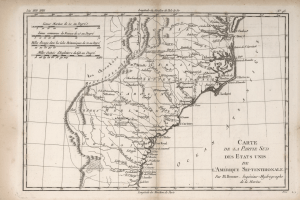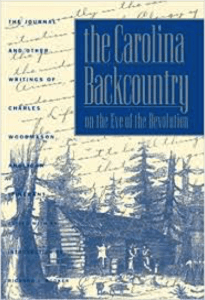Charles Woodmason and His Hearers
by Caroline Kester
The Great Awakening was a religious revival that swept through the British North American colonies during the eighteenth century. After the Church of England was established in Great Britain, the colonists were faced with a lack of fervor and excitement in their Christian faith. Many people saw this as a colony wide issue and wanted to do something about it. Their actions sparked the movement we now know as the Great Awakening and these people were known as revivalists. There are many well-known revivalists that had large impacts across the colonies. However, one revivalist in particular that interests me the most is Charles Woodmason.
Charles Woodmason was an English man who arrived in the colonies around the early 1750s. He initially settled in what we know today as the low country of South Carolina, more specifically, the Georgetown and Charleston areas. He stayed in the low country for around ten years before he began his backcountry journey. During his time in the low country, he was a planter, merchant, and clergyman among many of his other titles. From accounts of his personal journal, we can assume he enjoyed his time in the low country and in the Anglican community; he often wrote positively about the churches, community, and other members of the clergy.
 While he enjoyed his time, Woodmason felt called to reach more people in South Carolina, so he returned to England and was later assigned a post to St. Marks Parish, after he returned to the colonies. After returning, he traveled many miles through the backcountry of South Carolina, which consisted of many less developed areas in the middle to upper regions of South Carolina. During his two years, he traveled around giving many sermons, officiating weddings, baptizing, and getting to know the locals. His outreach was far as he traveled over six thousand miles, baptized over a thousand and two hundred children, and gave two hundred or more sermons. However, while it seems Woodmason reached and changed the lives of many, he often negatively recounted his interactions with the people of the backcountry.
While he enjoyed his time, Woodmason felt called to reach more people in South Carolina, so he returned to England and was later assigned a post to St. Marks Parish, after he returned to the colonies. After returning, he traveled many miles through the backcountry of South Carolina, which consisted of many less developed areas in the middle to upper regions of South Carolina. During his two years, he traveled around giving many sermons, officiating weddings, baptizing, and getting to know the locals. His outreach was far as he traveled over six thousand miles, baptized over a thousand and two hundred children, and gave two hundred or more sermons. However, while it seems Woodmason reached and changed the lives of many, he often negatively recounted his interactions with the people of the backcountry.
This is distaste for the backcountry and its people is one of Woodmason’s well known attributes. In is Journal he frequently spoke of the natives negatively, referring to their clothing, food, behavior, beliefs, and anything else he found unlikeable. He found them less civilized and it was clear he was much fonder of the low country. However, he still continued on and his outreach was very influential, regardless of his personal sentiments. Woodmason also had specific troubles with the Baptists and Presbyterians. They often refused to listen to him and disagreed with his sermons. Many Baptists and Presbyterians were set in their beliefs and not very fond of Woodmason trying to alter them. Regardless of many of his unfavorable circumstances and distaste for the backcountry, Woodmason still had great influence within the Carolinas and inspired great change during the Great Awakening.
 Through my story map, one can see how far and often Woodmason traveled. His frequent trips and his accounts of sermons, baptisms, and marriages will be obvious. But, his reaction and opinions to the people he is interacting with, especially in the backcountry, is what will shape the interest. Because, even though Woodmason is known as a revivalist, I think his distaste for the communities he was working with is what makes him interesting and more well-known. If someone was to read his journal or learn more about him, I think they would find his distaste shocking because many assume he or any revivalist would not speak so negatively. In the published version of his journal, The Carolina Backcountry on the Eve of Revolution, he gives very specific accounts and descriptions of all of his encounters. This gives historians a larger picture of what Woodmason was really like and his journal also gives great insight about the area at the time. From my story map, I have chosen ten points that I think particularly illuminate Woodmason’s distaste for the backcountry, but also how frequently and far he traveled.
Through my story map, one can see how far and often Woodmason traveled. His frequent trips and his accounts of sermons, baptisms, and marriages will be obvious. But, his reaction and opinions to the people he is interacting with, especially in the backcountry, is what will shape the interest. Because, even though Woodmason is known as a revivalist, I think his distaste for the communities he was working with is what makes him interesting and more well-known. If someone was to read his journal or learn more about him, I think they would find his distaste shocking because many assume he or any revivalist would not speak so negatively. In the published version of his journal, The Carolina Backcountry on the Eve of Revolution, he gives very specific accounts and descriptions of all of his encounters. This gives historians a larger picture of what Woodmason was really like and his journal also gives great insight about the area at the time. From my story map, I have chosen ten points that I think particularly illuminate Woodmason’s distaste for the backcountry, but also how frequently and far he traveled.
Further Resources
To learn more about the Great Awakening and Charles Woodmason in the South I would suggest reading Thomas S. Kidd’s book The Great Awakening: The Roots of Evangelical Christianity in Colonial America. We read this book in class and it offered great supplementary information. Another book that would be beneficial to read is The Great Awakening by William D. Holmes. If you are still in need of more information, I would suggest reading Inventing “the Great Awakening” by Frank Lambert.
